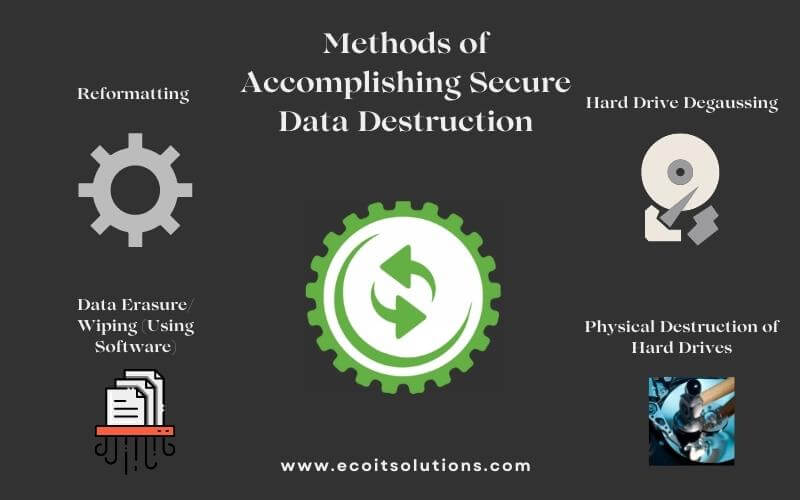Checking Out the Value of Data Damage in the Context of Computer Safety And Security Providers and Protecting Confidential Information
In a period where information breaches are progressively common, the relevance of efficient data damage can not be overemphasized. When no much longer essential, Organizations needs to embrace strict measures to make certain that delicate info is not only protected throughout its lifecycle however also decisively eradicated. The approaches utilized for information elimination, combined with conformity to lawful requirements, play a critical duty in preserving confidentiality and trust fund. The implications of these practices expand beyond plain compliance, affecting a company's credibility and functional integrity in the electronic industry. What techniques can companies implement to boost their information devastation methods?
Understanding Data Devastation
Information damage is a crucial element of computer system safety and security that includes the irreversible elimination of information from storage space devices to stop unauthorized access and possible information breaches. In a progressively electronic landscape, companies encounter enhanced dangers linked with delicate details being improperly accessed or exploited. Efficient information destruction safeguards versus these risks, making sure that personal dataâEUR" such as consumer details, intellectual building, and monetary recordsâEUR" can not be recuperated after disposal.
Comprehending the value of information destruction prolongs beyond mere compliance with legal and regulatory frameworks; it is crucial for keeping business honesty and depend on. When data is incorrectly handled or inadequately destroyed, the consequences can be extreme, consisting of financial loss, reputational damages, and lawful obligations.

Techniques of Information Elimination

One widespread method is data cleaning, which includes overwriting existing information with arbitrary patterns numerous times. This strategy makes the initial information irretrievable, making it a popular option for organizations seeking to protect confidential information.
An additional method is degaussing, which uses a powerful magnetic field to disrupt the magnetic domains on storage devices, efficiently removing the data. This approach is particularly effective for magnetic media yet is not relevant to solid-state drives.
Physical devastation is an additional durable technique, including the shredding or crushing of storage space gadgets. This technique guarantees that data recuperation is practically impossible, making it perfect for highly delicate info.
Finally, encryption can work as a complementary strategy to information removal. By encrypting information prior to deletion, organizations can include an additional layer of protection, making certain that even if residues are recuperated, they continue to be hard to reach without the decryption secret. Each technique must be picked based upon the level of data level of sensitivity and the particular security needs of the organization.
Legal Conformity and Data Protection
Organizations need to navigate a complicated landscape of legal needs connected to data safety and security, especially after carrying out techniques of information elimination. Various laws, such as the General Data Defense Policy (GDPR) and the Wellness Insurance Coverage Transportability and Liability Act (HIPAA), impose rigorous guidelines on just how organizations should take care of and dispose of delicate data. Failing to abide by these policies can cause significant lawful repercussions, including significant penalties and reputational damage.
Information devastation procedures need to be diligently documented to demonstrate compliance with suitable regulations and requirements. This documentation not only functions as proof of adherence to legal responsibilities yet also shows a dedication to guarding delicate details. Organizations should additionally establish clear policies relating to information retention and damage timelines, making certain that information is not held longer than necessary.

In addition, normal audits and analyses of information damage practices are necessary to keep conformity and adjust to progressing legal frameworks (data destruction). By proactively addressing lawful demands, organizations can reduce risks linked with data breaches and demonstrate their commitment to data security. Inevitably, focusing on legal conformity in information devastation procedures is not just a regulatory commitment, however a fundamental facet of a durable information safety and security strategy
Influence on Service Credibility
The reputation of an organization can be substantially affected by its approach to information destruction and monitoring. In today's digital landscape, where information breaches can take place anytime, the failing to correctly get rid of sensitive info can lead to serious repercussions. Organizations that improperly manage data devastation risk revealing confidential consumer information, which not just violates personal privacy regulations however additionally erodes depend on among customers and stakeholders.
A damaged online reputation can result in reduced consumer loyalty, as customers come to be hesitant to engage with an organization that has shown oversight in securing their data. Negative promotion bordering an information violation can have a long-term effect, as potential clients may be discouraged by the perceived absence of safety. This can bring about a straight decrease in revenue and market share.
Moreover, services that focus on data damage as part of their safety method can improve their credibility more info here by showcasing their dedication to securing delicate info. By embracing strict data management practices, organizations can not only reduce risks however also position themselves as trustworthy entities in their respective sectors, thus strengthening their overall brand photo.

Finest Practices for Secure Disposal
Executing best techniques for safe disposal of data is necessary for mitigating risks connected with information breaches and making certain conformity with privacy laws. Organizations ought to adopt a thorough data disposal plan that describes treatments for both physical and electronic information devastation.
For physical data storage space gadgets, such as disk drives, shredding or degaussing is suggested to avoid information recovery. Furthermore, companies need to preserve a chain of custodianship documents during the disposal procedure, ensuring liability websites and traceability of disposed products.
For electronic data, making use of software that follows industry criteria for data wiping is important. This software program needs to overwrite existing data several times, making recovery basically impossible. It is likewise vital to verify the efficiency of the information devastation process via audits or third-party assessments.
Training workers on safe and secure disposal practices adds one more layer of security, as human error can often result in information direct exposure. Frequently updating and evaluating disposal policies ensures alignment with advancing guidelines and technological developments. By applying these ideal methods, companies can dramatically lower the threat of unapproved information accessibility and boost their total data protection technique.
Final Thought
In final thought, data damage is an essential aspect of computer security services that ensures the defense of personal details from unapproved gain access to. Executing effective techniques of data removal, adhering to lawful conformity, and acknowledging the effect on company reputation are vital elements of an extensive information protection method. By embracing best techniques for safe disposal, organizations can promote count on with customers and secure sensitive information, eventually contributing to an extra safe electronic landscape.
In an age where information breaches are increasingly usual, the importance of effective data devastation can not be overemphasized.Information damage is an essential element of computer protection that entails the long-term site web elimination of information from storage space devices to protect against unauthorized accessibility and potential information breaches. Organizations must also develop clear plans relating to information retention and destruction timelines, making certain that data is not held longer than needed.
By proactively addressing lawful needs, organizations can alleviate risks connected with information breaches and show their dedication to data safety (data destruction). Ultimately, prioritizing lawful compliance in data devastation processes is not just a regulative commitment, however a basic aspect of a durable data safety approach